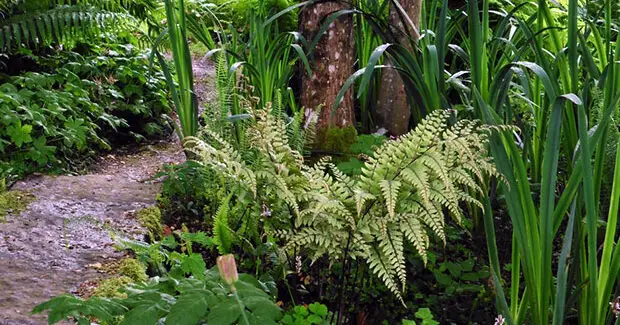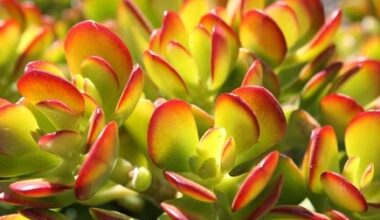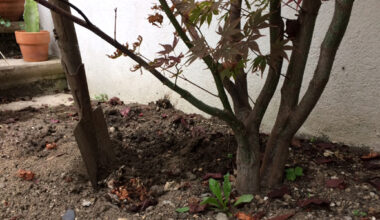Far from being an inconvenience, the shadowy corners of the garden can be arranged with pretty plants! Indeed, some plants do not tolerate direct sunlight and bloom in cool places, at the foot of a tree for example.
To enjoy a lush garden for many years, install shady perennials. These live and flower for at least two years.
Contents
10 wild plants to put in the shade
1. Ferns
Ferns are plants that enjoy shady and relatively cool situations, and some are particularly well adapted to rocky outcrops! They are irreplaceable to bring a very natural look to the garden. Polypodium vulgare and Asplenium trichomanes are content with very little substrate and are able to grow on low walls!
You can also choose the Scolopendre, which sometimes grows spontaneously in areas of scree or on old walls, in a relatively cool and shady situation. For an original effect, you can opt for the Coniogram emeiensis, which has green fronds streaked with yellow.
Also discover the Cyrtomium falcatum, a fern that has large, dark green, shiny, cut fronds reminiscent of the foliage of the mahonia.
2. Saxifrages
Saxifrages are lovely little plants ideal for rock gardens or to decorate a low wall. They carry a decorative foliage, as well as beautiful small simple and starry flowers, sometimes joined together in vaporous inflorescences, very light. We advise you in particular the Saxifraga umbrosa ‘Variegata’, which carries green leaves variegated with yellow and offers in spring small white flowers.
It is best planted in a cool, semi-shaded spot. The Saxifraga x urbium has beautiful green leaves and very delicate pinkish-white flowers. It is also called “Despair of the painter”, because of the extremely light and vaporous character of its bloom. Discover also the Saxifraga stolonifera ‘Cuscutiformis’, which has original leaves, of a hue varying between green and brown, with some pink shades and beautiful silvery white marbling.
It also offers beautiful inflorescences, ample and vaporous, consisting of small white flowers. Finally, in mid-shade, choose the Saxifraga x arendsii, which forms small mosslike carpets and bears pink, red or white flowers.
3. Grasses
Some small grasses are very interesting to bring a little volume and lightness in a rockery. Many species of Carex can adapt to shady situations! They will also appreciate if the ground is relatively wet. You can for example choose the Carex morrowii ‘Variegata’ or ‘Ice Dance’, which offer a very beautiful green foliage with creamy white shades.
In the same style, discover the Carex oshimensis ‘Evergold’, with green and yellow leaves. The Carex flacca is also interesting, with its bluish foliage. To bring a lot of luminosity, choose the Hakonechloa macra ‘Aureola’, which offers a superb golden yellow foliage, with a cascading fall.
Finally, the alfalfa, Luzula sylvatica, is also interesting, for its beautiful green leaves and its light flowering, in spikelets.
4. Tiarella
Tiarella is a superb plant with decorative foliage and vaporous bloom. It offers in spring of the light inflorescences, composed of small white or pink flowers. The leaves can take various colors: green, yellow, bronze, purple… They are palmate and have more or less cut lobes.
The foliage of the Tiarellas reminds a little of the heuchera, which they are very close to, and with which they can hybridize to give the Heucherellas. The Tiarellas like to grow in relatively cool, humus-rich and light soils.
We advise you in particular the culture of Tiarella wherryi, a charming small perennial with pinkish white flowers and tender green foliage, more or less marked with brown along the veins.
5. The sagina
The subulate sagina (Sagina subulata) forms dense and uniform carpets, of a beautiful green hue, resembling a little moss. It is covered in spring with small white flowers, very simple, with five petals. It effectively covers the ground, and will fill without problem the empty spaces between the stones within a rockery. It remains very low, not exceeding 2 inches in height.
It will enable you to constitute a very beautiful green and fresh decoration, to emphasize other more colorful blooms. The sagina is also ideal to compose a bed of Japanese inspiration, or a rock garden within a Zen garden.
6. The ajuga reptans
The creeping flugelhorn, or Ajuga reptans, is a ground-cover perennial with purple-green evergreen foliage and blue flowers. It spreads thanks to its runners, and limits the growth of weeds. It is rather low, and rarely exceeds 8 inches in height.
It is a plant which one can easily find in the wild state in France. Its flowers are bilabiate (forming two lips), and are grouped on small erect stems. Certain varieties are interesting for their very dark purple foliage (like Ajuga reptans ‘Atropurpurea’), or variegated (Ajuga reptans ‘Variegata’); others are distinguished by their white (Ajuga reptans ‘Alba’), or dewy (Ajuga reptans ‘Purple Torch’) flowers.
7. The hostas
Hostas are very beautiful shade plants, with a lush appearance, and which form interesting clumps for their decorative foliage, taking on beautiful shades. Their leaves are ample and broad; they can be green, bluish, golden, variegated of white… One also appreciates their bloom, in the form of bells of white or clear mauve color. The hostas like in the fresh grounds, even wet, deep, and rather rich in organic matter.
For a rockery, we advise you to choose preferably those of small size, like the varieties ‘Blue Mouse Ears’, ‘Diamond Tiara’, ‘Stiletto’, or ‘Warwick Delight’… The varieties which have a variegated foliage of white or cream are ideal to bring luminosity!
8. The corydale
The corydales are small perennial plants which have a beautiful cut foliage and a long bloom, consisting of small colorful and elongated flowers. They require very little maintenance, and can be resown spontaneously in the garden!
They will easily find their place between stones, in a shaded rockery. They appreciate the relatively cool, rich and draining soil. We advise you in particular to cultivate the species Corydalis solida, which has purple-mauve flowers. Discover also the Corydalis flexuosa, with blue flowers.
9. The epimedium
The Epimedium, also called Elf Flower, is a lovely perennial that offers small bell-shaped flowers. The latter have an extremely delicate, very fine appearance. Depending on the variety, they can take on a mauve – lilac, pinkish white, yellow, orange… The foliage is also decorative, with a changing hue according to the seasons.
It can be deciduous or evergreen, depending on the species. The Epimedium is ideal for a naturalist, wild style garden. It appreciates fresh soil, is resistant, not very sensitive to diseases, and requires almost no maintenance.
10. The Lamium
Lamium is a ground-cover plant which offers a decorative and serrated foliage, resembling a little bit that of nettles, as well as flowers often pink, mauve or white, sometimes yellow. Those have an irregular shape, with petals divided into two lips, and are gathered in the armpit of the leaves.
Discover in particular the Lamium maculatum, which offers purple – mauve flowers, sometimes white (as in the Lamium maculatum ‘White Nancy’). Some varieties have beautiful silvery white variegated foliage.
Shade, an opportunity or a constraint for your garden?
Do you want to embellish every corner of your exterior? An area of your garden is in the shade or in semi-shade and you want to arrange it? Even if your garden is not very sunny, you can flower it and arrange it to your taste, thanks to adapted plants with evergreen foliage.
It is quite possible to make these spaces lush, even very colorful. The secret to the success of such a project lies in the choice of the plants you will grow. Because even if the shaded areas can bring certain constraints, many flowering plants and ground covers will grow there wonderfully. This even in a small garden.
Summary
When the shade is permanent, under trees or under bamboos, it is better to choose species originating from undergrowth.
Accustomed to the lack of light, native wild species have, for the most part, ample and abundant foliage. This allows them to capture a maximum of light and produces lush scenes.








